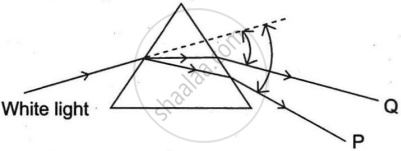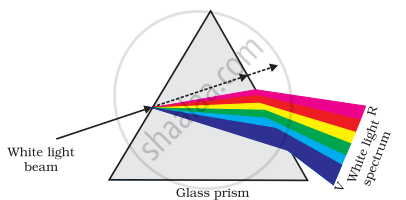Advertisements
Advertisements
Question
In the following diagram showing dispersion of white light by a glass prism, the colours 'P' and 'Q’ respectively are:

Options
Red and Violet
Violet and Red
Red and Blue
Orange and Green
Solution
Violet and Red
Explanation:
The splitting of white light into its constituent colours is known as light dispersion. The spectrum is the band of seven colours produced by splitting white light. All of the constituent colours of white light have the same velocity in vacuum, but their velocity changes when they pass through a transparent 'medium' like a glass prism. Different colours are diverted by different angles on the prism's initial face. Violet's minimum speed is deviated by the maximum angle, whereas red's maximum speed is distorted by the minimum angle. As a result, the letters 'P' and 'Q' are violet and crimson, respectively.

RELATED QUESTIONS
A student is observing a diagram showing the path of a ray of light passing through a glass prism. He would find that for all angles of incidence the ray of light bends:
(i) A ray of white light breaks up into its components while passing through a glass prism. Draw a ray diagram to show the path of rays.
(ii) Mark the least deviated colour in your diagram

(iii) Why do different coloured rays deviate differently in a prism?
Which is refracted most by a prism : red light or violet light? Explain why?
Which of the following colour of white light has the least wavelength?
(a) red
(b) orange
(c) violet
(d) blue
The phenomenon of splitting of light into its component colours is ___________ .
Write the range of wavelength of the ultraviolet spectrum.
Which of the following is a natural phenomenon which is caused by the dispersion of sunlight in the sky?
Why do we see a rainbow in the sky only after rainfall?
What is Newton’s disc?
______ colour is deviated the least in the spectrum of white light obtained with a glass prism.
